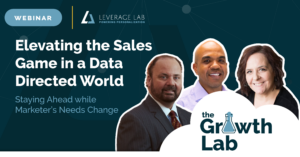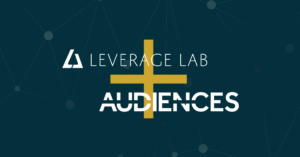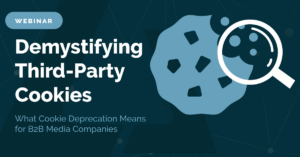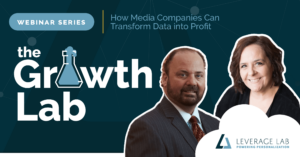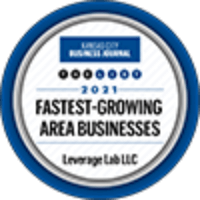An Interview With Pierre Brunelle as featured on Medium’s Authority Magazine.
As part of our series about “How To Effectively Leverage Data To Take Your Company To The Next Level”, I had the pleasure of interviewing AnnMarie Wills.
AnnMarie Wills is the co-founder and CEO of Leverage Lab, a first-party data integrator that works with businesses to fully leverage the power of their first-party data. Her team of strategists, data engineers and campaign managers help businesses create deeper relationships and new revenue opportunities with every connection. First-party data has become a key strategy for marketers to withstand the shifting sands caused by regulatory compliance, big tech and privacy. With more than 20 years of experience, AnnMarie has worked with forward-thinking businesses around the globe that believe in the power of first-party data to drive improved business performance and hedge against market forces. It’s a first-party data revolution and AnnMarie and Leverage Lab are leading the way.
——
Thank you so much for joining us in this interview series. Before we dive in, our readers would love to “get to know you” a bit better. Can you tell us a bit about your ‘backstory’ and how you got started?
I’ve been obsessed with the idea of leveraging customer data to build more personalized messaging since the 1990s. Early in my career, I ran direct-mail subscription marketing for major metropolitan newspapers, and I learned that if we could really tailor the subscription offer language, highlight pertinent content, and provide value-added offers that really resonated with the target audience, our offer acceptance was dramatically better. However back then it was painfully manual, and the juice almost wasn’t worth the squeeze. Yet, I felt like we were on the verge of a world where it was all possible and it was powered by technology.
Flash forward to today, we live in a world where most enterprise companies can have up to a dozen different marketing, sales and fulfillment systems storing fragmented customer data. Think about it, consumers have very high expectations of personalization, thanks to Netflix, Spotify, Amazon, etc. They expect you to act as you know them, just don’t be too creepy. Juxtaposed to that consumer desire for a “known” experience we have increased data privacy and regulatory compliance that make building a relationship much more challenging for marketers. To me, the answer lies in building a connected value exchange between the brand and the consumer to the point that consumers will provide the data and the access for marketers to build that connected relationship. In a nutshell that is a first-party data strategy … part hard, data work, and part, authentic, privacy-first customer interaction. It’s truly an art and science. I saw an opportunity several years ago and decided to jump out of corporate America with my business partner to build a company that solves the challenges businesses face. Leverage Lab is the deepest and broadest customer-data integrator that helps improve revenue at every stage of a customer journey.
Can you share a story about the funniest mistake you made when you were first starting? Can you tell us what lessons or ‘takeaways’ you learned from that?
When I was first toying with the concept of highly targeted subscription offers in publishing, it was very early in my career, and I was making decisions about strategy based entirely on my gut and my belief in data-driven marketing. In the newspaper industry, at the time there was a standard playbook for this work, and I was not running those plays. I had supportive management willing to try new things and my ignorance of what I was “supposed” to be doing was on display. I had no fear of failing because I hadn’t failed at that scale before, so I just plowed ahead. This new way was successful and during a time when many newspapers were suffering declining subscriptions, we were one of the only U.S. major metro papers holding their own. I guess the funny part looking back is thinking I was just having a blast doing what I thought was the right thing to do, not realizing most of the people in my industry were laughing behind my back. The take-away for me was that data is always going to steer you in the right direction. Leaning into connecting consumers with things that are relevant to them is never, ever going to be wrong.
Is there a particular book, podcast, or film that made a significant impact on you? Can you share a story or explain why it resonated with you so much?
Very early on it was the book The One-to-One Future by Don Peppers and Martha Rogers. It was significant for me because it prophetically forecasted a future of data-driven personalization. At the time, it was like science fiction to me, and I was all in. Not sure I would recommend it today as it is a bit dated, talking about the Fax Machine and the Mobile Phone as examples of channel activation for personalization. The Minority Report is another example of science fiction and reality getting uncomfortably close. I’m a huge fan of James Gleick and Malcolm Gladwell. I also enjoy a few podcasts (mostly about music and culture), and I do enjoy The Actionable Futurist by Andrew Grill.
Are you working on any new, exciting projects now? How do you think that might help people?
We are working with transformational technology helping marketers organize and better leverage their first-party data. This category of technology is known as a Customer Data Platform and it’s fast becoming a critical component of the marketing technology stack. We are building some exciting extensions of the CDP to address better media buying decisions and contextual content recommendations. It’s using what you know about people and their behavior to inform the next set of decisions and actions you, as a marketer will take. We’re attracting some top-tier brands to our way of thinking and strategic approach. And, the work we’re doing is challenging, exciting and very fulfilling. Especially when we hear results of 600% ROI or 4 times the lift. That gets us fired up.
Thank you for all that. Let’s now turn to the main focus of our discussion about empowering organizations to be more “data-driven.” My work centers on the value of data visualization and data collaboration at all levels of an organization. So, I’m particularly interested in this topic. For the benefit of our readers, can you help explain what exactly it means to be data-driven? On a practical level, what does it look like to use data to make decisions?
That’s a big question. A truly data-driven company is using data in every aspect of the business. For some focus let’s point at marketing and customer journey management, which is our specific lens on the world. No matter what you sell or how you make money, your customers go through a journey to become your customer. There is the simple act of becoming aware of your services and products, through a consideration step. It’s where engagement with products and services occurs through a conversion, whatever that looks like for a business. In our view, the best use of data, particularly customer data, is to improve and personalize at every step of the customer journey.
On a practical level, let me share how improving the customer journey with data can look and feel. I buy a lot of my clothes from one online vendor, which I won’t name here. I’m not an over-the-top shopper, but I do spend a considerable amount and you could say my lifetime value is quite high because I’ve shopped here for many years. I receive an email nearly every day and often I click through the email and land on their website. Sometimes when I land there, the site will fire a pop-up asking for my email address. For most consumers, we just click the popup off and move on. This is a CLEAR indication that data is NOT attached to the customer journey to optimize the shopping experience. This online retailer has the power to connect their data to my visit in a much more personal manner.
They know precisely who I am, my style preference, frequency of shopping, my favorite color of shoes, apparel and scarves. How about heightening the fanfare around my visit with a little extra love since I am a loyal customer? Rather than indicating they don’t know who I am … because they asked for my email address after I just clicked through from an email, they sent me!
Most consumers just move on without a second thought. However, statistically, we know if that retailer were making a little extra effort to personalize my visit based on data and behavior, I will buy more. And that retailer can offer a broader diversity of products, more frequently and over a longer period. That’s why you use customer data to personalize the customer experience.
Take it a step further, they know it’s 31 degrees outside where I live, and I might need a new scarf to go with that jacket I bought last week. That’s how we ring up more sales. And this is just scraping the surface of how we’re helping companies today.
Which companies can most benefit from tools that empower data collaboration?
Every company can benefit from tools that empower data collaboration, but only if they have a data infrastructure to manage the data to be democratized. Buying data visualization tools are quite meaningful if the company has a data infrastructure and clear metrics to be delivered to the organization, and a clear plan for how to react to the metrics delivered. I’ve seen many companies invest in data tools without a clear plan for what they will do with those tools. For instance, in our practice around Customer Data Platforms, we often hear stakeholders say, “My use case for CDP is that I want to organize all my customer data and build a singular view of all my customers.” Yes, that is the function of the CDP, but what do you want to use that data to do? Very often there isn’t a strong response. We work backward from clearly defined goals to develop strategies for the journey. Is it more items in an e-commerce shopping cart? Broader awareness of other offerings from a B2B partner?
We’d love to hear about your experiences using data to drive decisions. In your experience, how has data analytics and data collaboration helped improve operations, processes, and customer experiences? We’d love to hear some stories if possible.
As we discussed, we help our customers leverage their data to create more personalized customer journeys. For our e-commerce customers, we leverage technology to ensure that every step in the customer journey, from the first ads a prospect sees to the personalized emails they receive years after they first become a customer, each engagement, each marketing message will hit better when personalized.
Here’s a great example, we work with a large quick-service restaurant chain, currently building a first-party data infrastructure, specifically to personalized customer experiences. Their typical advertising approach would be to lean into targeting available through their existing advertising channels, Google, Facebook, etc. – we call those walled gardens. In the walled gardens, they would choose audiences based on what Facebook and Google know rather than using their data that tends to be richer and more relevant. So, we did a head-to-head test using two audiences. One built-in the walled gardens and one a lookalike audience based on their actual customers. The offer was simple, buy one, get one free beverage. The test was to see which would perform better, the audience created in the walled gardens based on their insights, or the lookalike audience created from purchasers of that exact beverage item.
The net result was 2X more redemptions from the lookalike audience. This is a perfect story of how data-driven approaches can pay off for various companies and consumer brands.
Another example is our work with publishers and media organizations. They can monetize audiences who are consuming content on their sites. By leveraging their first-party data, media companies can better understand what specific users like and don’t like in their content and personalize the content recommendations to drive deeper engagement. This translates into more page views, more click-throughs and overall better user experiences. Wins all the way around.
Has the shift towards becoming more data-driven been challenging for some teams or organizations from your vantage point? What are the challenges? How can organizations solve these challenges?
From our vantage point around customer data, it’s a very challenging change management process. Think about traditional marketing workflow. Much of a marketer’s time is spent trying to munge data and move it around for activation. Rather than blasting the masses for small gains and wasted budgets, you should flip the traditional marketing funnel upside down and focus energy and money where it matters.
In a new environment where your data is coordinated, organized, resolved and available, the workflow from the marketer changes. The work becomes more creative, finding the high-value audiences and the messages you want to create to deepen the relationship and move people through the customer journey to produce greater outcomes. It’s a significant mind shift that affects marketers, media agencies, creative teams, and more. Solving these challenges starts at the outset with clear use case development, goal setting, organizational planning and success measures. The efforts can pay off enormously.
Ok. Thank you. Here is the primary question of our discussion. Based on your experience and success, what are “Five Ways a Company Can Effectively Leverage Data to Take It To The Next Level”? Please share a story or an example for each.
- Better Customer Experiences – From simply ensuring your VIP customers are known throughout the organization, to creating data-driven personalization at scale, it’s about improving customer experiences that translate into better customer outcomes. One simple example is by leveraging lookalike audiences based on your customer data and building a more personalized set of messaging. One of our clients saw a 100% drop in cost per acquisition for a high-end, professional certification course.
- Competitive Advantage – Leveraging your customer data can help identify unmet needs and opportunities, plus position an organization well to respond to changing market conditions. We work with many publishers who are hard hit by changes big tech enacted in the advertising ecosystem. For those who have a first-party data strategy, these changes have less impact. For those who don’t, there is significant catching up to do.
- Supercharge the Customer Journey – Consumer behaviors are increasingly trending more digital. COVID simply accelerated the speed. With more and more of your customer interactions happening digitally, enhancing those interactions with insight from your data is imperative. In B2B organizational buying, this is dramatically more pronounced given the educational buying cycle and diverse buying influencers. For our B2B clients, using their first-party data to coordinate and orchestrate campaign activation can significantly shorten buying cycles.
- Product Development – The use of data to find gaps in your products and services seems like a natural opportunity, yet it’s challenging to know where to begin. For retailers, analyzing high-value audiences against a product mix can uncover niche buyer opportunities for expansion. For publishers, analyzing the content interests for high-value audiences can uncover newsletter, event or other monetizable product development opportunities.
- Laser Targeting – Despite the limiting factors of DMPs and the demise of third-party cookies, data can still be used by brand marketers for robust, laser targeted campaigns. Between data collected in research panels, existing customer data, third-party data providers and the use of AI for continuous learning, data can take you from a wide-angle lens to a microscopic view with precision. That means your return on ad spend gets a huge boost with way less waste. Our major consumer brand client realized a significant return on ad spend through an optimized strategy. They took their bonus funds and reinvested it to grab more market share.
The name of this series is “Data-Driven Work Cultures”. Changing a culture is hard. What would you suggest is needed to change a work culture to become more Data-Driven?
I believe it’s a clarity of vision and an understanding that change is an iterative process. We think of this along a maturity curve. An organization doesn’t go from excel reports distributed monthly to predictive analytics overnight. Setting appropriate goals around high-value applications of data will drive early success, which is critical to long-term change. Sometimes an organization needs help seeing where the high-value applications of data lie so bringing in outside consulting with key knowledge can help focus efforts.
The future of work has recently become very fluid. Based on your experience, how do you think the needs for data will evolve and change over the next five years?
Work is changed forever. All workers want more flexibility and the ability to work where they choose. For organizations, I believe that will make their project management and other organizational systems critically important for maintaining productivity and a sane work environment for teams. Rather than investments in real estate and office-bound perks, companies will be investing in well-tuned operational systems and services that help their employees manage their work-life balance. The ways we measure and improve performance in this new world will be data-driven, so developing the metrics that will aid in the management of the new workplace will be critical.
Does your organization have any exciting goals for the near future? What challenges will you need to tackle to reach them? How do you think data analytics can best help you?
All our goals for the future include finding new methods to leverage data to drive business performance. Some of the things we are working on include advanced recommendation tools for retailers. Currently, most digital retail and quick service restaurant product recommendations are either completely uninformed, based on general popularity, or similar to past purchases or current product views. We are working on a more contextual recommendation system that optimizes the shopping experience against an ideal purchase model. For restaurants, instead of offering a predetermined item for up-sale, why not create the “perfect purchase” based on the individual consumer. It’s 100% possible and proven to increase product purchase diversity, average order value and repeat purchase behaviors. Every innovation we create has an element of informing your next decision with the performance of your last decision. The challenges lie in education about the benefits and opportunities. The data work is hard but that’s what we do, and we deliver new ideas.
How can our readers further follow your work?
Follow us on LinkedIn or our active blog on our website.
Thank you so much for sharing these important insights. We wish you continued success and good health!


